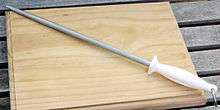Honing steel


A honing steel, sometimes referred to as sharpening steel, sharpening stick, sharpening rod, butcher's steel, and chef's steel is a rod of steel, ceramic or diamond coated steel used to realign blade edges. They are flat, oval, or round in cross-section and up to one foot long (30 cm). The steel and ceramic honing steels may have longitudinal ridges, whereas the diamond coated steels are smooth but will be embedded with abrasive diamond particles.[1]
The naming ("honing" or "sharpening") is often a misnomer, because the traditional "honing steel" neither hones nor sharpens a blade. Instead, its function is to realign a curled edge rather than remove metal from the edge. The term "hone" is associated with light maintenance performed on a blade without the effort and precision normally associated with sharpening, so the name "hone" was loaned. In the 1980s, ceramic abrasives became increasingly popular, and proved an equal, if not superior, method for accomplishing the same daily maintenance tasks; manufacturers replaced steels with ceramic (and later, manufactured diamond abrasive) sharpening "steels" that were, in fact, hones.
Use
Honing steels are used by lightly placing the near edge of the blade against the base of the steel, then sliding the blade away from yourself along the steel while moving it down – the blade moves diagonally, while the steel remains stationary. This should be done with the blade held at an angle to the steel, usually about 20°, and repeating on the opposite side at the same angle. This is repeated five to ten times per side.[1]
Steeling
It is often recommended that steeling be performed immediately before or after using a knife,[2] and can be done daily.[1] By contrast, knives are generally sharpened less frequently. A traditional smooth honing steel is of no use if the edge is blunt, because it removes no material; instead it fixes deformations along the edge of a sharp blade , technically known as burnishing. There has long been speculation about the efficacy of steeling (re-aligning the edge) vs honing (removing minor deformation with abrasives); studies tend to favor abrasives for daily maintenance, especially in high-carbide-volume "stainless" steels (such as the popular CPM S30V, which tends to "tear out" when steeled rather than re-forming an edge.)[3]
Usage trends
Steels have traditionally been used in the West, especially in heavy use scenarios (e.g. butchering, where the edge deforms due to forceful contact with bone). These scenarios also lead Western trends toward blades tempered to a lower level of hardness (and thus, lower brittleness). In East Asia, notably Japan, harder knives are preferred, so there is little need for steeling intra-day, as the edge does not deform as much. Instead, the blade is honed as needed on a waterstone. While tradition has kept the practice of steeling alive in Western kitchens, the majority of Honing Steels sold are abrasive rather than smooth, and knives are harder and more frequently made of stainless steel, which does not respond to traditional steeling techniques as well as high-carbon/low alloy tool steels.[4]
See also
References
- 1 2 3 Sur la Table; Jay, Sarah; Fink, Ben (2008). Knives Cooks Love: Selection. Care. Techniques. Recipes. Andrews McMeel Publishing. pp. 59–61. ISBN 978-0-7407-7002-9.
- ↑ Bryan Miller (April 20, 2005). "Kitchen Equipment Secrets". National Public Radio. Retrieved 2010-11-17.
- ↑ Verhoeven, John (2004). Experiments on Knife Sharpening (PDF) (Technical report). ISU.
- ↑ Stamp, Cliff (2012). Review:Mousetrap steel from Razor Edge (Technical report). ISU.